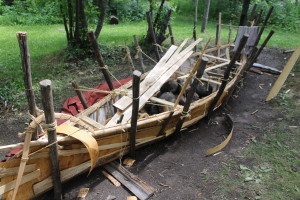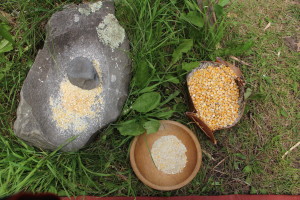People often ask us how Tom and I got interested in Living History. We kind of fell into it to begin with. We applied to our first national park gig because of the location in Death Valley (after the 2014 winter in Ohio I just wanted to go someplace warm for the winter). Working at Scotty’s Castle was the only position open at Death Valley that didn’t involve being a campground host. There isn’t anything wrong with being a campground host but your primary responsibilities are enforcing rules and you are on call 24/7. We wanted something with more regular hours. So we applied for, and got, positions at Scotty’s Castle, which just turned out to be living history interpretive positions. We got to wear historic clothing, give tours, interact with visitors and we loved it. Since that first position, we have looked for positions that are in the interpretive division of the national park service and that have some element of living history.
Tom and I joke that we are going back in time. We started out in 1930 at Scotty’s, went to 1863 at Chickamauga, and then even further back to 1780 at King’s Mountain. Here at Grand Portage we are living in 1797. Every day we wear our costumes and interpret life in the 1790’s at a fur depot. When we move to Fort Frederica in January, we will be living in the 1730’s, so we will have been in the 18th century for more than a year.

We like living history because we get to immerse ourselves in an era. Not only do we learn people and events, but we learn how people lived and try to live that way ourselves. We learn what people in 1797 knew: how to hunt and trap, what foods are available, how to cook those foods. We read journals and reports to see what trade goods were here, how people traveled, and what they saw along the way. We talk to the other rangers about how to do something in the appropriate way for the time.
For instance: the Ojibwe didn’t have metal kettles before the fur traders came. How did they make soup or boil meat over a fire? They traded, occasionally, for pottery pots, but they also used birchbark containers. But wouldn’t the birchbark burn up? We have been experimenting with different methods of boiling water in birchbark containers. When the containers are very fresh, you can place them over the fire without them burning. But you can also put hot rocks in the containers or in wooden bowls to heat things up. The arrival of metal kettles certainly made a simple thing like boiling water easier.

We have had a chance to try things that would have been necessary for survival. I spent a day grinding corn with a stone mortar and pestle. After several hours I had enough meal for one cornbread recipe! Hard work for a little reward, but I was so proud of that cornmeal.
Tom has become an expert at starting fires and loves to give demonstrations on the three methods available at the time: bow, flint and steel, and magnifying lens. He gathers a crowd whenever he is working at one of these and, when he has time, teaches kids how to do it. The other day a boy burned himself using the magnifying lens but, as soon as the hurt went out of the burn, he wanted to try it again. I think kids would pay more attention to history lessons if they could live for a week as they did as a Revolutionary soldier or a Civil War soldier. And some of our national parks are encouraging just that, like King’s Mountain Epic Patriot Camp.
We are enjoying our time doing living history. We have learned to appreciate the knowledge of “those old guys” and the clever ways they figured out to do things. And we no longer take for granted the convenience of our truck or microwave.

So glad you shared the beginning of your retirement. As I shared your ER episode with the Anhorns we all wondered what prompted you and Tom to do what you are doing. This blog gives us some of your thoughts and how you went about it. Many thanks. I so miss traveling and your sharings do help me. Nan Cuckler
Always love to hear from you, Nan. I’m glad you are staying in touch via the blog. You were always so great about sharing your travels with me – I’m glad I can return the favor.